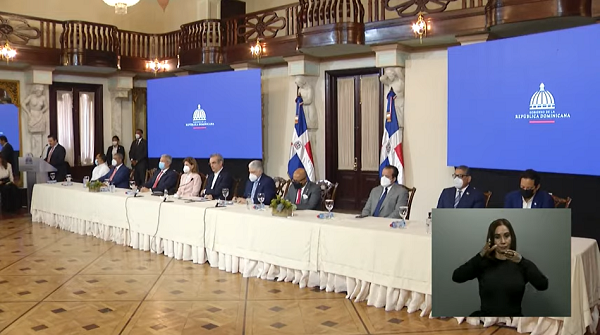
President Luis Abinader is committed to actions that make the country one of the most productive, competitive and equitable countries in the world. On 15 September 2021, the President presented his government’s National Competitiveness Strategy. The objective is to turn the country into the most competitive in the Central American region by 2024
Speaking during the presentation at the Presidential Palace, the President said he is convinced that the dream that the country be the most competitive in Latin America by 2030 and one of the twenty most competitive countries in the world by 2040 can be achieved if all sectors work together.
The National Competitiveness Strategy encompasses the reforms to reduce red tape to facilitate investing and doing business in the Dominican Republic.
“I invite you to dream of a better country, but also to build it, setting a critical path with clear and ambitious goals, and with precise dates for its implementation,” proposed Abinader.
The President reflected on how in the past 50 years many countries have overcome stagnation and solved their structural problems through ambitious and transversal reform agendas.
He noted that there is no relationship between the size of a country and its success. Some large countries, he pointed out, that have experienced great economic progress are China and, more recently, India. Others are medium-sized, such as South Korea, Vietnam or even Spain. But he stressed there are also small countries with success stories, such as Hong Kong, Singapore, the United Arab Emirates or neighboring Costa Rica.
He urged for all to work together to kickstart the changes needed. “Let us recover trust and credibility among the different actors of society, so that we do not have to continue looking for individual solutions to collective problems,” he stressed. He emphasized the effort will result in improvements in the standard of living for all Dominicans.
He recalled that on 11 November 2020 he had entrusted the National Competitiveness Council (CNC) to develop the National Competitiveness Strategy that he presented on 15 September. The initiative is aligned with the National Development Strategy and is based on the competitive advantages that the country possesses.
“The strategy that we are presenting today seeks not only to redefine public policies and set the priorities for economic reactivation, but must also be able to anticipate the challenges that the fourth industrial revolution and the post-Covid-19 era are bringing,” he emphasized.
President Abinader says that Bureaucracy Simplification Law 167-21 is key to the reducing government red tape. During the event, he mentioned the government has identified 1,873 procedures in 53 institutions that affect efficiency and cost Dominicans some RD$264 billion a year, equivalent to 5.5% of the GDP. The objective is to give priority to the simplifying of 274 procedures that are responsible for 60% of the costs.
As part of the National Competitiveness Strategy, the Abinader government has already achieved the passing of the modernized Customs Law (Law 168-21) with an updated customs regulatory scheme that facilitates trade and commerce.
At the presiding table of the event were Vice President Raquel Peña; the presidents of the Senate of the Republic, Eduardo Estrella; of the Chamber of Deputies, Alfredo Pacheco and the executive director of the National Competitiveness Council, Peter Prazmowski.
Read more in Spanish:
Presidency
Hoy
Diario Libre
Regulatory Improvement and Simplification of Procedures Law 167-21
16 September 2021

